Financial Reporting: Qualitative Characteristics and Concepts Analysis
VerifiedAdded on 2020/10/22
|7
|1610
|355
Report
AI Summary
This report delves into the core principles of financial reporting, emphasizing the crucial role of the International Accounting Standards Board (IASB) framework. It meticulously assesses the fundamental and enhancing qualitative characteristics, such as relevance, faithful representation, comparability, and understandability, highlighting their significance in providing quality financial information. The report illustrates how these concepts and assumptions, including recognition, measurement, and disclosure, are applied to financial statements to ensure they are reliable, relevant, and useful for stakeholders like investors and creditors. Furthermore, it explores key assumptions like economic entities, going concern, and monetary unit, illustrating their impact on financial reporting practices. The report concludes by summarizing the importance of these concepts in producing accurate and transparent financial statements.
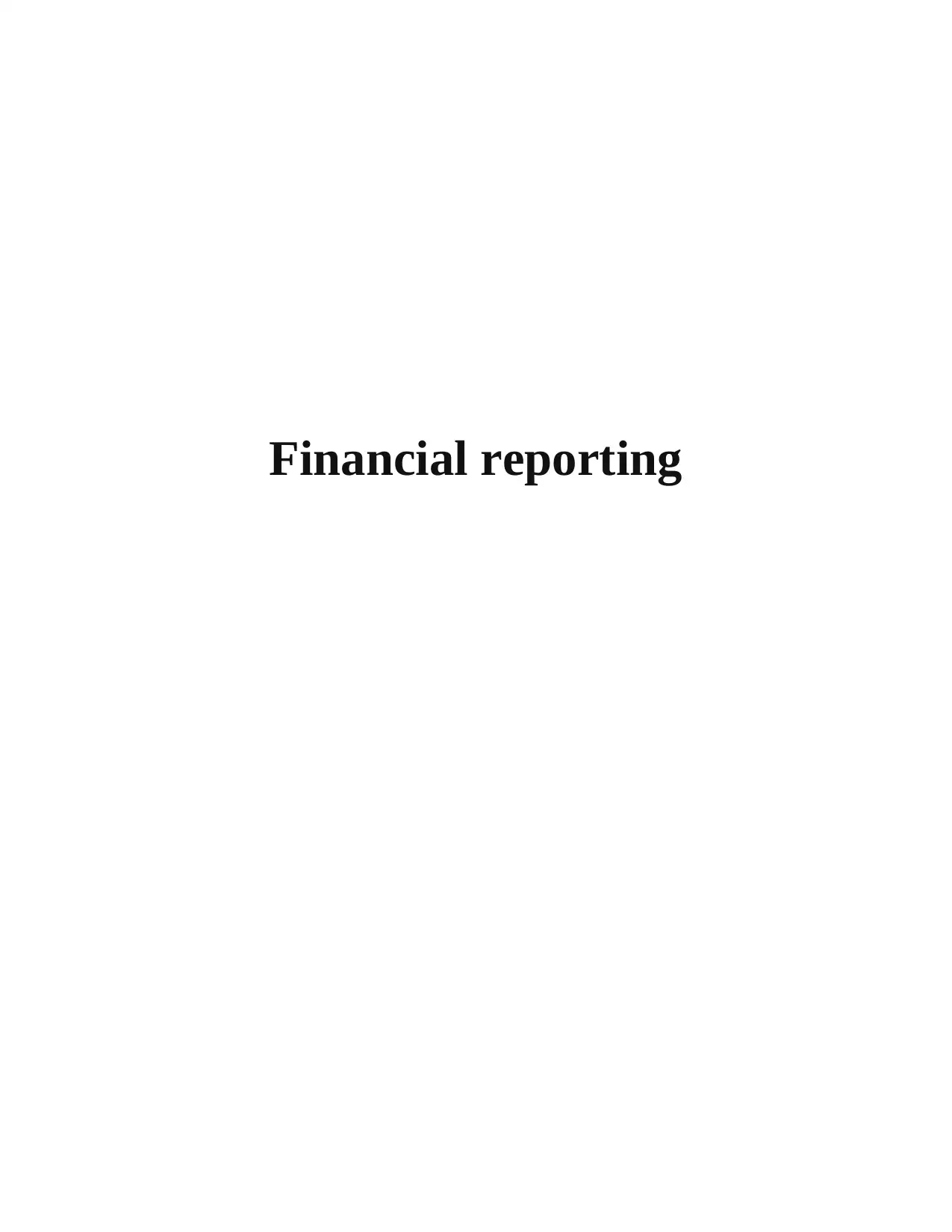
Financial reporting
Paraphrase This Document
Need a fresh take? Get an instant paraphrase of this document with our AI Paraphraser
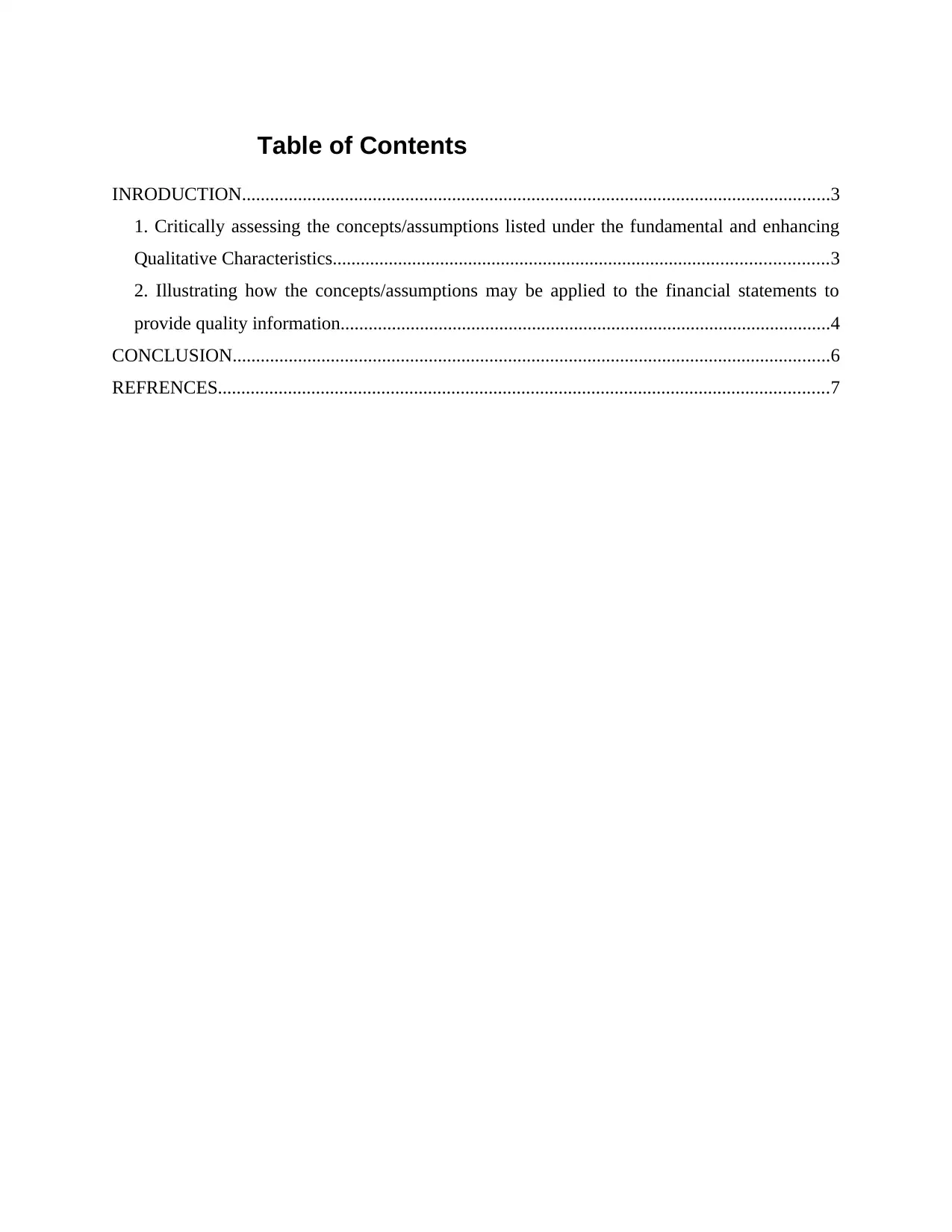
Table of Contents
INRODUCTION..............................................................................................................................3
1. Critically assessing the concepts/assumptions listed under the fundamental and enhancing
Qualitative Characteristics..........................................................................................................3
2. Illustrating how the concepts/assumptions may be applied to the financial statements to
provide quality information.........................................................................................................4
CONCLUSION................................................................................................................................6
REFRENCES...................................................................................................................................7
INRODUCTION..............................................................................................................................3
1. Critically assessing the concepts/assumptions listed under the fundamental and enhancing
Qualitative Characteristics..........................................................................................................3
2. Illustrating how the concepts/assumptions may be applied to the financial statements to
provide quality information.........................................................................................................4
CONCLUSION................................................................................................................................6
REFRENCES...................................................................................................................................7
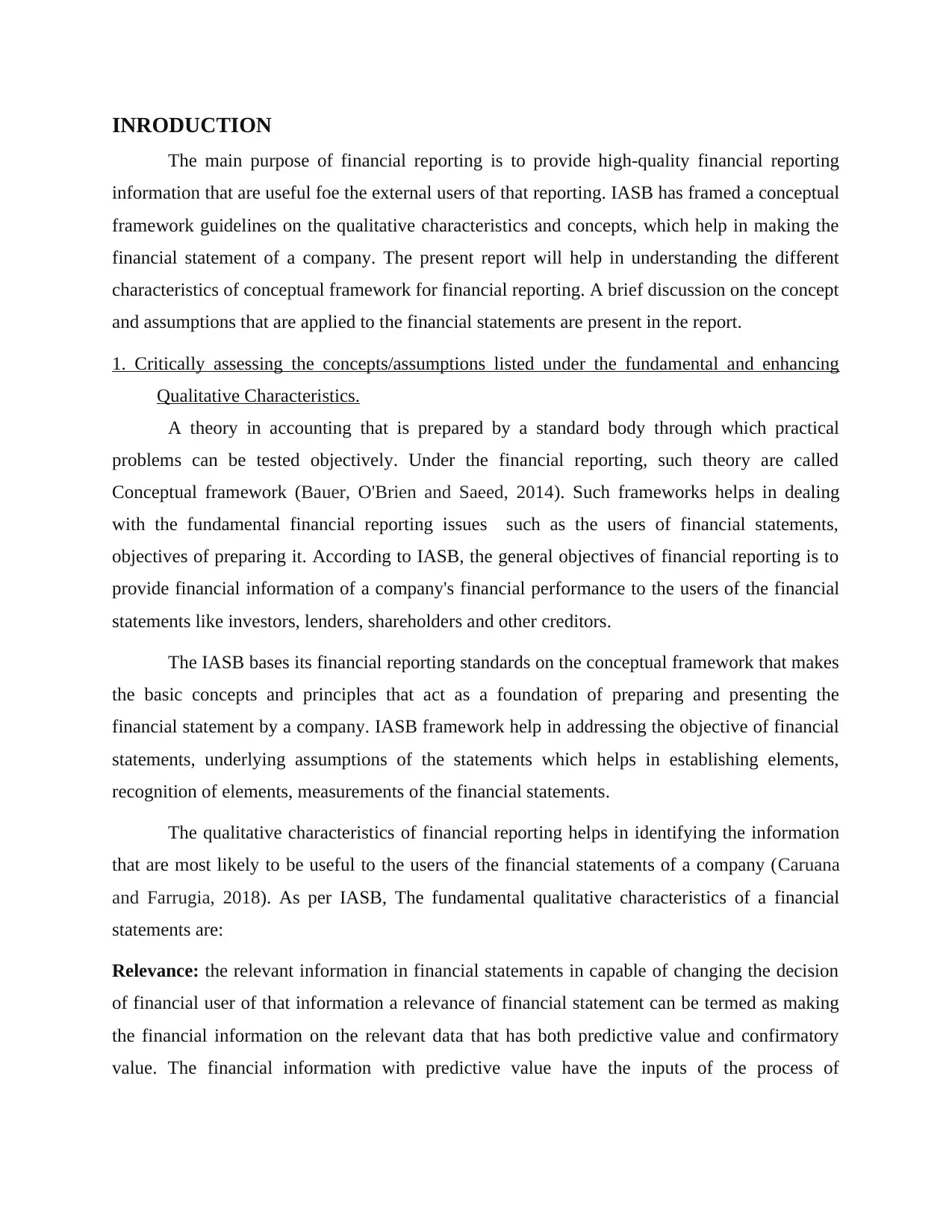
INRODUCTION
The main purpose of financial reporting is to provide high-quality financial reporting
information that are useful foe the external users of that reporting. IASB has framed a conceptual
framework guidelines on the qualitative characteristics and concepts, which help in making the
financial statement of a company. The present report will help in understanding the different
characteristics of conceptual framework for financial reporting. A brief discussion on the concept
and assumptions that are applied to the financial statements are present in the report.
1. Critically assessing the concepts/assumptions listed under the fundamental and enhancing
Qualitative Characteristics.
A theory in accounting that is prepared by a standard body through which practical
problems can be tested objectively. Under the financial reporting, such theory are called
Conceptual framework (Bauer, O'Brien and Saeed, 2014). Such frameworks helps in dealing
with the fundamental financial reporting issues such as the users of financial statements,
objectives of preparing it. According to IASB, the general objectives of financial reporting is to
provide financial information of a company's financial performance to the users of the financial
statements like investors, lenders, shareholders and other creditors.
The IASB bases its financial reporting standards on the conceptual framework that makes
the basic concepts and principles that act as a foundation of preparing and presenting the
financial statement by a company. IASB framework help in addressing the objective of financial
statements, underlying assumptions of the statements which helps in establishing elements,
recognition of elements, measurements of the financial statements.
The qualitative characteristics of financial reporting helps in identifying the information
that are most likely to be useful to the users of the financial statements of a company (Caruana
and Farrugia, 2018). As per IASB, The fundamental qualitative characteristics of a financial
statements are:
Relevance: the relevant information in financial statements in capable of changing the decision
of financial user of that information a relevance of financial statement can be termed as making
the financial information on the relevant data that has both predictive value and confirmatory
value. The financial information with predictive value have the inputs of the process of
The main purpose of financial reporting is to provide high-quality financial reporting
information that are useful foe the external users of that reporting. IASB has framed a conceptual
framework guidelines on the qualitative characteristics and concepts, which help in making the
financial statement of a company. The present report will help in understanding the different
characteristics of conceptual framework for financial reporting. A brief discussion on the concept
and assumptions that are applied to the financial statements are present in the report.
1. Critically assessing the concepts/assumptions listed under the fundamental and enhancing
Qualitative Characteristics.
A theory in accounting that is prepared by a standard body through which practical
problems can be tested objectively. Under the financial reporting, such theory are called
Conceptual framework (Bauer, O'Brien and Saeed, 2014). Such frameworks helps in dealing
with the fundamental financial reporting issues such as the users of financial statements,
objectives of preparing it. According to IASB, the general objectives of financial reporting is to
provide financial information of a company's financial performance to the users of the financial
statements like investors, lenders, shareholders and other creditors.
The IASB bases its financial reporting standards on the conceptual framework that makes
the basic concepts and principles that act as a foundation of preparing and presenting the
financial statement by a company. IASB framework help in addressing the objective of financial
statements, underlying assumptions of the statements which helps in establishing elements,
recognition of elements, measurements of the financial statements.
The qualitative characteristics of financial reporting helps in identifying the information
that are most likely to be useful to the users of the financial statements of a company (Caruana
and Farrugia, 2018). As per IASB, The fundamental qualitative characteristics of a financial
statements are:
Relevance: the relevant information in financial statements in capable of changing the decision
of financial user of that information a relevance of financial statement can be termed as making
the financial information on the relevant data that has both predictive value and confirmatory
value. The financial information with predictive value have the inputs of the process of
⊘ This is a preview!⊘
Do you want full access?
Subscribe today to unlock all pages.

Trusted by 1+ million students worldwide
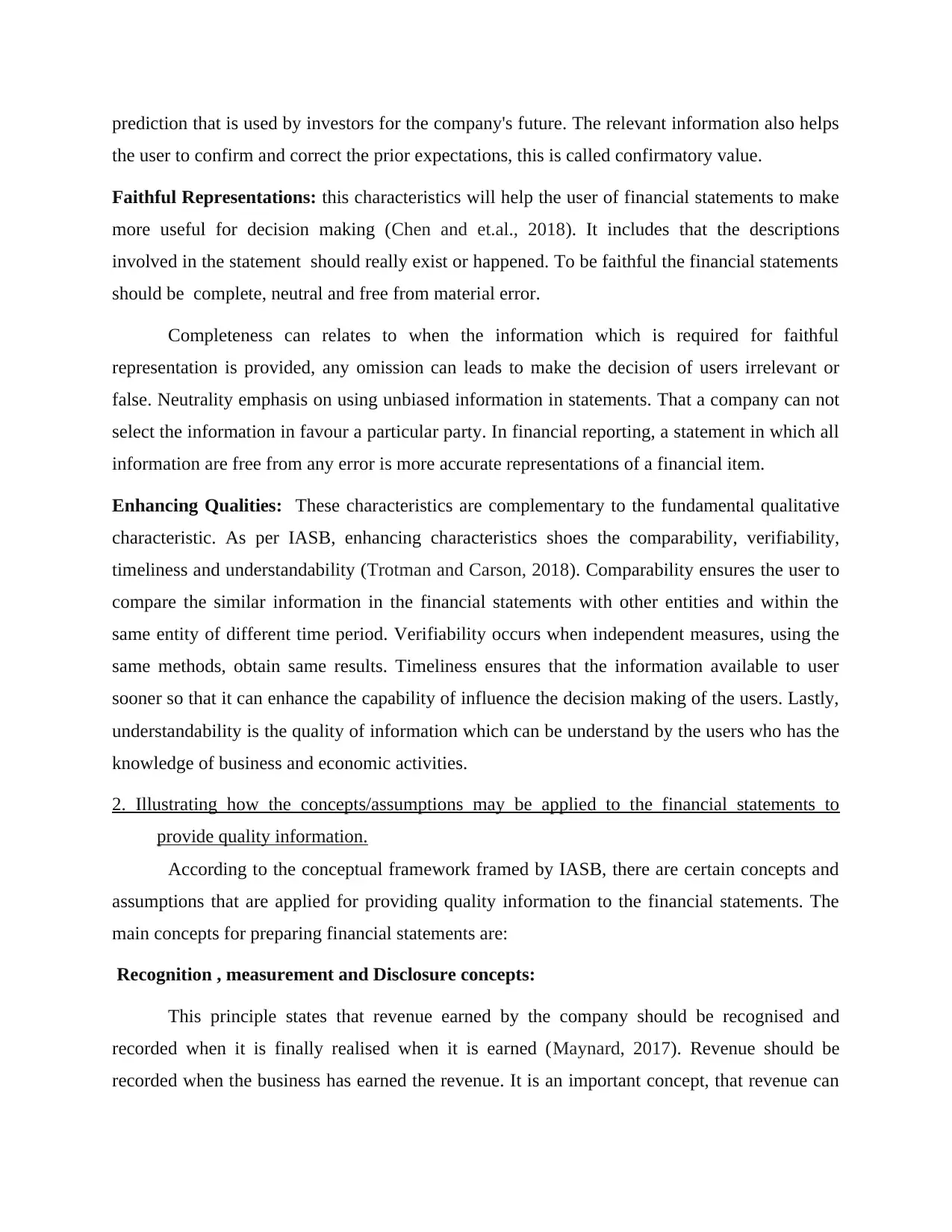
prediction that is used by investors for the company's future. The relevant information also helps
the user to confirm and correct the prior expectations, this is called confirmatory value.
Faithful Representations: this characteristics will help the user of financial statements to make
more useful for decision making (Chen and et.al., 2018). It includes that the descriptions
involved in the statement should really exist or happened. To be faithful the financial statements
should be complete, neutral and free from material error.
Completeness can relates to when the information which is required for faithful
representation is provided, any omission can leads to make the decision of users irrelevant or
false. Neutrality emphasis on using unbiased information in statements. That a company can not
select the information in favour a particular party. In financial reporting, a statement in which all
information are free from any error is more accurate representations of a financial item.
Enhancing Qualities: These characteristics are complementary to the fundamental qualitative
characteristic. As per IASB, enhancing characteristics shoes the comparability, verifiability,
timeliness and understandability (Trotman and Carson, 2018). Comparability ensures the user to
compare the similar information in the financial statements with other entities and within the
same entity of different time period. Verifiability occurs when independent measures, using the
same methods, obtain same results. Timeliness ensures that the information available to user
sooner so that it can enhance the capability of influence the decision making of the users. Lastly,
understandability is the quality of information which can be understand by the users who has the
knowledge of business and economic activities.
2. Illustrating how the concepts/assumptions may be applied to the financial statements to
provide quality information.
According to the conceptual framework framed by IASB, there are certain concepts and
assumptions that are applied for providing quality information to the financial statements. The
main concepts for preparing financial statements are:
Recognition , measurement and Disclosure concepts:
This principle states that revenue earned by the company should be recognised and
recorded when it is finally realised when it is earned (Maynard, 2017). Revenue should be
recorded when the business has earned the revenue. It is an important concept, that revenue can
the user to confirm and correct the prior expectations, this is called confirmatory value.
Faithful Representations: this characteristics will help the user of financial statements to make
more useful for decision making (Chen and et.al., 2018). It includes that the descriptions
involved in the statement should really exist or happened. To be faithful the financial statements
should be complete, neutral and free from material error.
Completeness can relates to when the information which is required for faithful
representation is provided, any omission can leads to make the decision of users irrelevant or
false. Neutrality emphasis on using unbiased information in statements. That a company can not
select the information in favour a particular party. In financial reporting, a statement in which all
information are free from any error is more accurate representations of a financial item.
Enhancing Qualities: These characteristics are complementary to the fundamental qualitative
characteristic. As per IASB, enhancing characteristics shoes the comparability, verifiability,
timeliness and understandability (Trotman and Carson, 2018). Comparability ensures the user to
compare the similar information in the financial statements with other entities and within the
same entity of different time period. Verifiability occurs when independent measures, using the
same methods, obtain same results. Timeliness ensures that the information available to user
sooner so that it can enhance the capability of influence the decision making of the users. Lastly,
understandability is the quality of information which can be understand by the users who has the
knowledge of business and economic activities.
2. Illustrating how the concepts/assumptions may be applied to the financial statements to
provide quality information.
According to the conceptual framework framed by IASB, there are certain concepts and
assumptions that are applied for providing quality information to the financial statements. The
main concepts for preparing financial statements are:
Recognition , measurement and Disclosure concepts:
This principle states that revenue earned by the company should be recognised and
recorded when it is finally realised when it is earned (Maynard, 2017). Revenue should be
recorded when the business has earned the revenue. It is an important concept, that revenue can
Paraphrase This Document
Need a fresh take? Get an instant paraphrase of this document with our AI Paraphraser
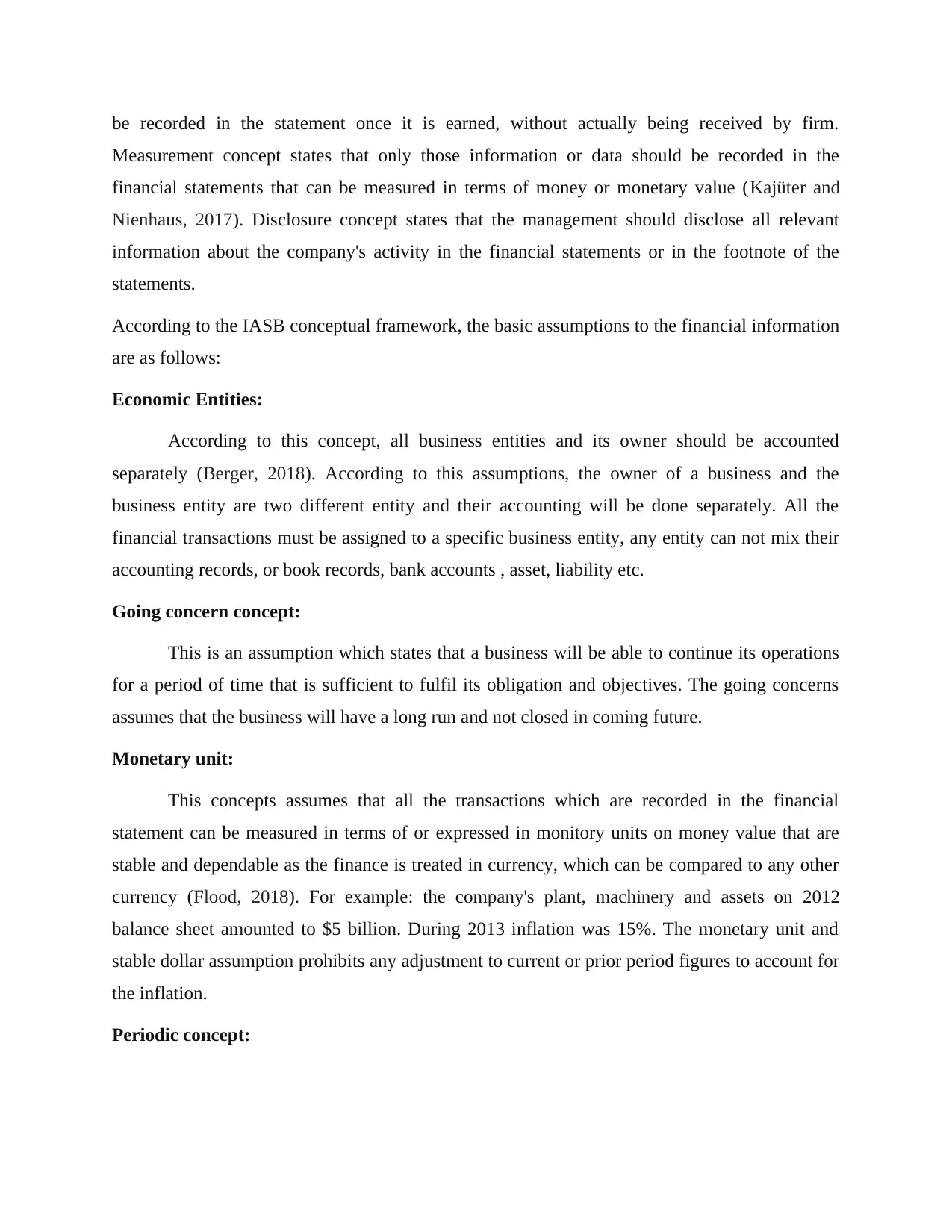
be recorded in the statement once it is earned, without actually being received by firm.
Measurement concept states that only those information or data should be recorded in the
financial statements that can be measured in terms of money or monetary value (Kajüter and
Nienhaus, 2017). Disclosure concept states that the management should disclose all relevant
information about the company's activity in the financial statements or in the footnote of the
statements.
According to the IASB conceptual framework, the basic assumptions to the financial information
are as follows:
Economic Entities:
According to this concept, all business entities and its owner should be accounted
separately (Berger, 2018). According to this assumptions, the owner of a business and the
business entity are two different entity and their accounting will be done separately. All the
financial transactions must be assigned to a specific business entity, any entity can not mix their
accounting records, or book records, bank accounts , asset, liability etc.
Going concern concept:
This is an assumption which states that a business will be able to continue its operations
for a period of time that is sufficient to fulfil its obligation and objectives. The going concerns
assumes that the business will have a long run and not closed in coming future.
Monetary unit:
This concepts assumes that all the transactions which are recorded in the financial
statement can be measured in terms of or expressed in monitory units on money value that are
stable and dependable as the finance is treated in currency, which can be compared to any other
currency (Flood, 2018). For example: the company's plant, machinery and assets on 2012
balance sheet amounted to $5 billion. During 2013 inflation was 15%. The monetary unit and
stable dollar assumption prohibits any adjustment to current or prior period figures to account for
the inflation.
Periodic concept:
Measurement concept states that only those information or data should be recorded in the
financial statements that can be measured in terms of money or monetary value (Kajüter and
Nienhaus, 2017). Disclosure concept states that the management should disclose all relevant
information about the company's activity in the financial statements or in the footnote of the
statements.
According to the IASB conceptual framework, the basic assumptions to the financial information
are as follows:
Economic Entities:
According to this concept, all business entities and its owner should be accounted
separately (Berger, 2018). According to this assumptions, the owner of a business and the
business entity are two different entity and their accounting will be done separately. All the
financial transactions must be assigned to a specific business entity, any entity can not mix their
accounting records, or book records, bank accounts , asset, liability etc.
Going concern concept:
This is an assumption which states that a business will be able to continue its operations
for a period of time that is sufficient to fulfil its obligation and objectives. The going concerns
assumes that the business will have a long run and not closed in coming future.
Monetary unit:
This concepts assumes that all the transactions which are recorded in the financial
statement can be measured in terms of or expressed in monitory units on money value that are
stable and dependable as the finance is treated in currency, which can be compared to any other
currency (Flood, 2018). For example: the company's plant, machinery and assets on 2012
balance sheet amounted to $5 billion. During 2013 inflation was 15%. The monetary unit and
stable dollar assumption prohibits any adjustment to current or prior period figures to account for
the inflation.
Periodic concept:
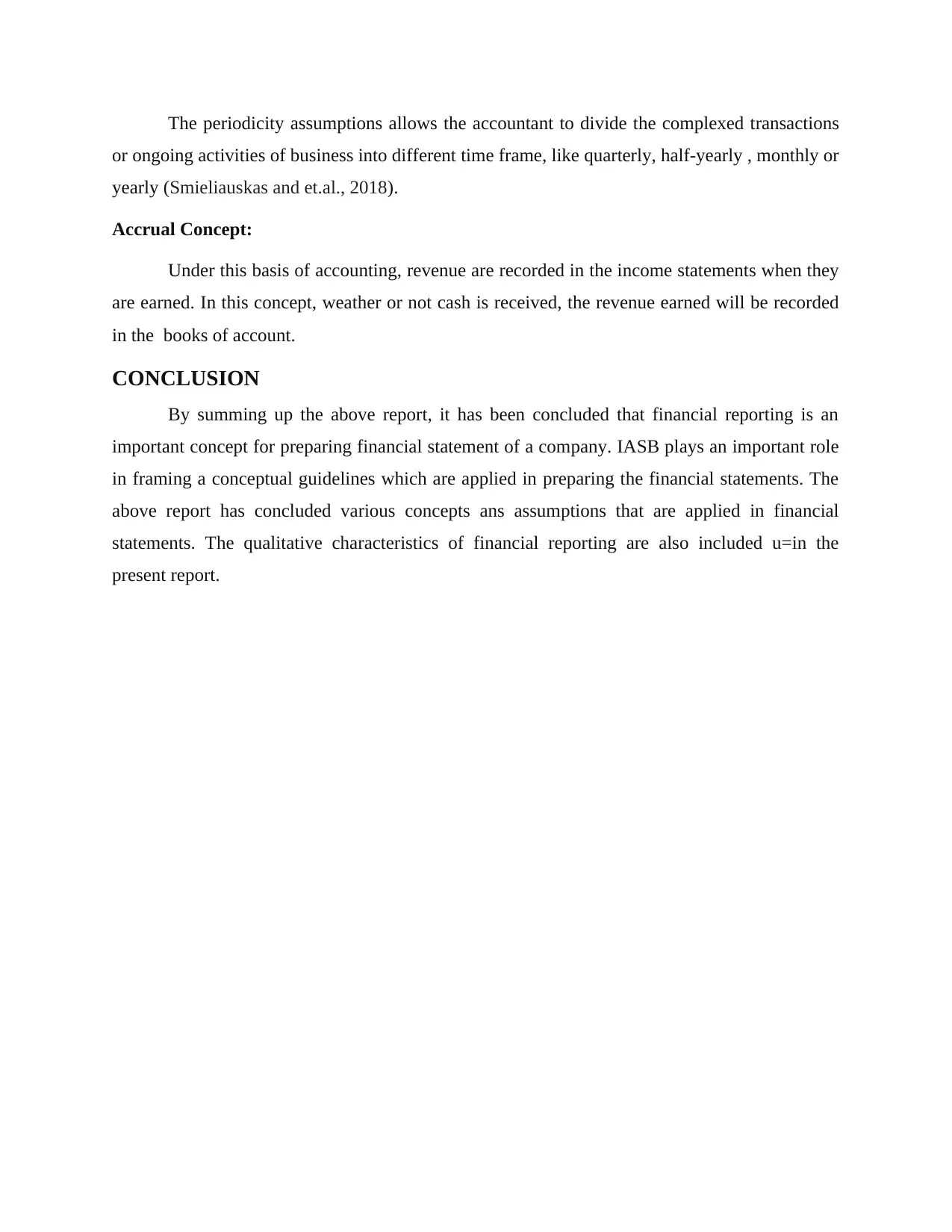
The periodicity assumptions allows the accountant to divide the complexed transactions
or ongoing activities of business into different time frame, like quarterly, half-yearly , monthly or
yearly (Smieliauskas and et.al., 2018).
Accrual Concept:
Under this basis of accounting, revenue are recorded in the income statements when they
are earned. In this concept, weather or not cash is received, the revenue earned will be recorded
in the books of account.
CONCLUSION
By summing up the above report, it has been concluded that financial reporting is an
important concept for preparing financial statement of a company. IASB plays an important role
in framing a conceptual guidelines which are applied in preparing the financial statements. The
above report has concluded various concepts ans assumptions that are applied in financial
statements. The qualitative characteristics of financial reporting are also included u=in the
present report.
or ongoing activities of business into different time frame, like quarterly, half-yearly , monthly or
yearly (Smieliauskas and et.al., 2018).
Accrual Concept:
Under this basis of accounting, revenue are recorded in the income statements when they
are earned. In this concept, weather or not cash is received, the revenue earned will be recorded
in the books of account.
CONCLUSION
By summing up the above report, it has been concluded that financial reporting is an
important concept for preparing financial statement of a company. IASB plays an important role
in framing a conceptual guidelines which are applied in preparing the financial statements. The
above report has concluded various concepts ans assumptions that are applied in financial
statements. The qualitative characteristics of financial reporting are also included u=in the
present report.
⊘ This is a preview!⊘
Do you want full access?
Subscribe today to unlock all pages.

Trusted by 1+ million students worldwide
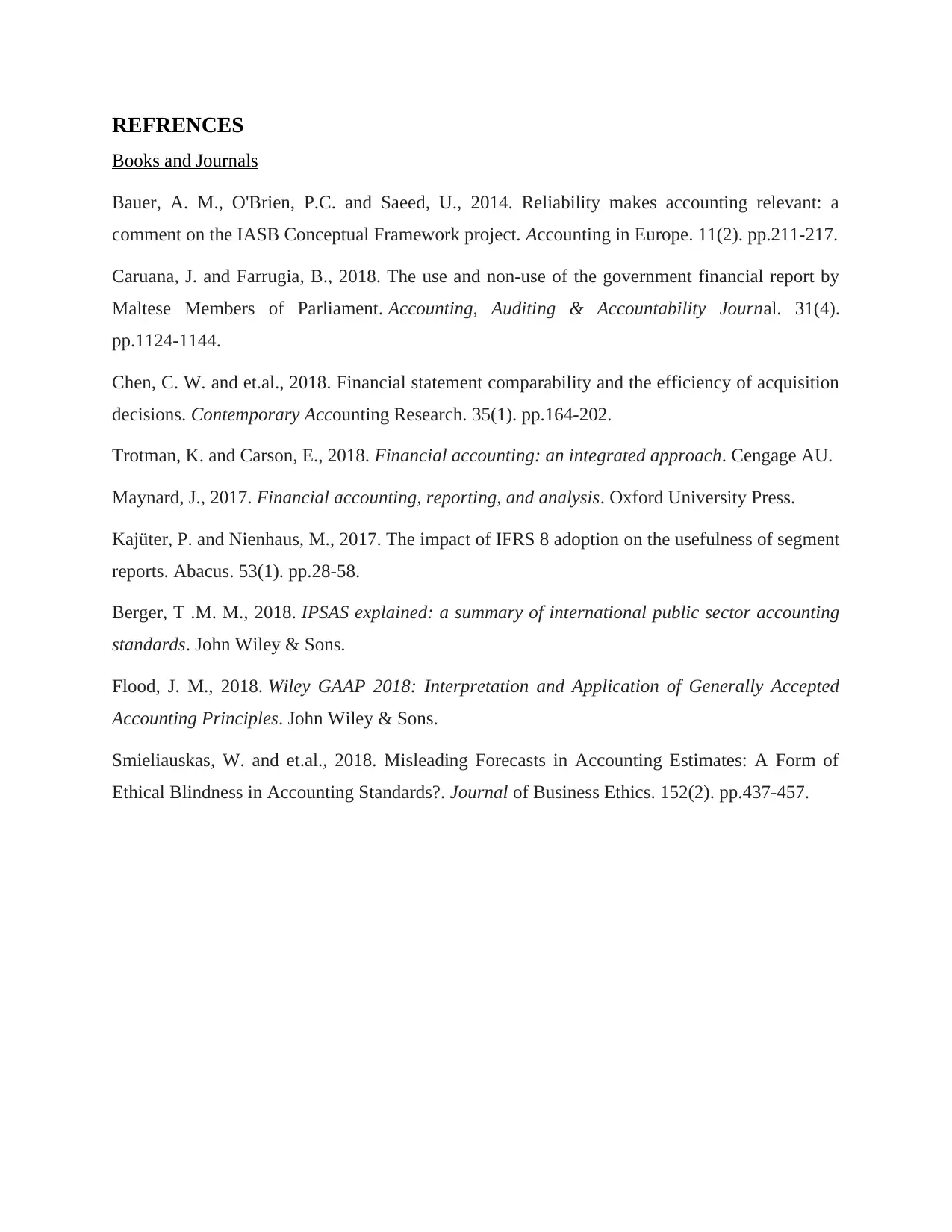
REFRENCES
Books and Journals
Bauer, A. M., O'Brien, P.C. and Saeed, U., 2014. Reliability makes accounting relevant: a
comment on the IASB Conceptual Framework project. Accounting in Europe. 11(2). pp.211-217.
Caruana, J. and Farrugia, B., 2018. The use and non-use of the government financial report by
Maltese Members of Parliament. Accounting, Auditing & Accountability Journal. 31(4).
pp.1124-1144.
Chen, C. W. and et.al., 2018. Financial statement comparability and the efficiency of acquisition
decisions. Contemporary Accounting Research. 35(1). pp.164-202.
Trotman, K. and Carson, E., 2018. Financial accounting: an integrated approach. Cengage AU.
Maynard, J., 2017. Financial accounting, reporting, and analysis. Oxford University Press.
Kajüter, P. and Nienhaus, M., 2017. The impact of IFRS 8 adoption on the usefulness of segment
reports. Abacus. 53(1). pp.28-58.
Berger, T .M. M., 2018. IPSAS explained: a summary of international public sector accounting
standards. John Wiley & Sons.
Flood, J. M., 2018. Wiley GAAP 2018: Interpretation and Application of Generally Accepted
Accounting Principles. John Wiley & Sons.
Smieliauskas, W. and et.al., 2018. Misleading Forecasts in Accounting Estimates: A Form of
Ethical Blindness in Accounting Standards?. Journal of Business Ethics. 152(2). pp.437-457.
Books and Journals
Bauer, A. M., O'Brien, P.C. and Saeed, U., 2014. Reliability makes accounting relevant: a
comment on the IASB Conceptual Framework project. Accounting in Europe. 11(2). pp.211-217.
Caruana, J. and Farrugia, B., 2018. The use and non-use of the government financial report by
Maltese Members of Parliament. Accounting, Auditing & Accountability Journal. 31(4).
pp.1124-1144.
Chen, C. W. and et.al., 2018. Financial statement comparability and the efficiency of acquisition
decisions. Contemporary Accounting Research. 35(1). pp.164-202.
Trotman, K. and Carson, E., 2018. Financial accounting: an integrated approach. Cengage AU.
Maynard, J., 2017. Financial accounting, reporting, and analysis. Oxford University Press.
Kajüter, P. and Nienhaus, M., 2017. The impact of IFRS 8 adoption on the usefulness of segment
reports. Abacus. 53(1). pp.28-58.
Berger, T .M. M., 2018. IPSAS explained: a summary of international public sector accounting
standards. John Wiley & Sons.
Flood, J. M., 2018. Wiley GAAP 2018: Interpretation and Application of Generally Accepted
Accounting Principles. John Wiley & Sons.
Smieliauskas, W. and et.al., 2018. Misleading Forecasts in Accounting Estimates: A Form of
Ethical Blindness in Accounting Standards?. Journal of Business Ethics. 152(2). pp.437-457.
1 out of 7
Related Documents
Your All-in-One AI-Powered Toolkit for Academic Success.
+13062052269
info@desklib.com
Available 24*7 on WhatsApp / Email
![[object Object]](/_next/static/media/star-bottom.7253800d.svg)
Unlock your academic potential
Copyright © 2020–2025 A2Z Services. All Rights Reserved. Developed and managed by ZUCOL.





